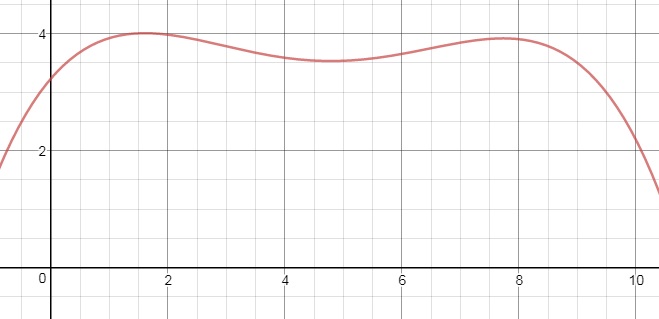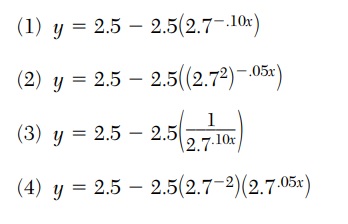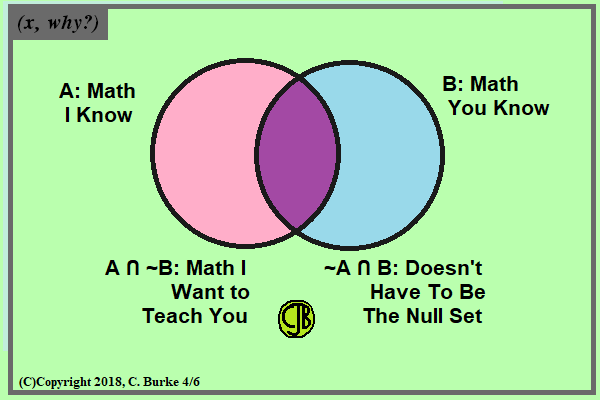The following are some of the multiple questions from the recent January 2018 New York State Geometry Regents exam.
The questions and answers to Part I can be found here.
The questions and answers to Part II can be found here.
January 2018 Geometry, Part III
Each correct answer is worth up to 4 credits. Partial credit is available. Work must be shown. Correct answers without work receive only 1 point.
32. Triangle ABC and triangle ADE are graphed on the set of axes below.
Describe a transformation that maps triangle ABC onto triangle ADE.
Explain why this transformation makes triangle ADE similar to triangle ABC
Answer: Triangle ABC is dilated by a scale factor of 3 centered on point A.
You can see that to get from A to B, you go 4 units up and 1 to the right. To go from A to D, you go 12 units up and 3 to the right. That is three times the distance. (This explanation is not needed for credit.)
Dilations preserve the shape, so angle size is preserved. Therefore, angle ABC is congruent to angle ADE, and angle ACB is congruent to angle AED. Also, angle A is congruent to itself. By AA, triangle ABC is similar to triangle ADE.
33. A storage tank is in the shape of a cylinder with a hemisphere on the top. The highest point on the
inside of the storage tank is 13 meters above the floor of the storage tank, and the diameter inside
the cylinder is 8 meters. Determine and state, to the nearest cubic meter, the total volume inside
the storage tank.
Answer: The radius of the cylinder is 1/2 of 8m, which is 4m, so the radius of the hemisphere is 4m, too.
This means that the height of the cylinder portion of the tank is 13 - 4 = 9m.
Volume of the cylinder = Area of Base X Height = (3.141592...)(4)2(9) (Note: do NOT use 3.14.)
Volume of the cylinder = 452.389342116...
Volume of the hemisphere = (1/2)(4/3)(3.141592...)(4)3 = 134.041286553
Total Volume = 452.39 + 134.04 = 586.43 = 586 m3. (Units are not necessary, but if included, MUST be correct.)
34. As shown in the diagram below, an island (I) is due north of a marina (M). A boat house (H) is 4.5 miles due west of the marina. From the boat house, the island is located at an angle of 54° from the marina.
Determine and state, to the nearest tenth of a mile, the distance from the boat house (H) to the
island (I).
Determine and state, to the nearest tenth of a mile, the distance from the island (I) to the
marina (M).
Answer: In the first part, you need to find the hypotenuse of the triangle. You are given the side adjacent to the given angle. Adjacent and hypotenuse mean that you need to use cosine.
cos 54 = 4.5/x
Then x = 4.5/(cos 54) = 7.65585727517 = 7.7.
In the second part, you can use either the tangent ratio or you can use Pythagorean Theorem. The problem with Pythagorean Theorem is that if you use 7.7 then you will not get the correct answer because you have rounded the data in the middle of the problem. (Using, say, 7.6559, for example, should be enough.)
tan 54 = y/4.5
Then y = (4.5)(tan 54) = 6.19371864212 = 6.2
Part IV
A correct answer is worth up to 6 credits. Partial credit is available.
35. In the coordinate plane, the vertices of triangle PAT are P(-1,-6), A(-4,5), and T(5,-2). Prove that triangle PAT is an isosceles triangle. [The use of the set of axes is optional.]
State the coordinates of R so that quadrilateral PART is a parallelogram.
Answer: To show that a triangle is isosceles, you must show that the length of two of its sides are the same. Use the distance formula three times to find the lengths of PA, AT and TP.
d(PA) = ( (-4 - -1)2 + (5 - -6)2 )(1/2)) = ( (-3)2 + (11)2 )(1/2)) = (9 + 121)(1/2))
= (130)(1/2))
d(AT) = ( (5 - -4)2 + (-2 - 5)2 )(1/2)) = ( (9)2 + (-7)2 )(1/2)) = (81 + 49)(1/2))
= (130)(1/2))
d(TP) = ( (-1 - 5)2 + (-6 - -2)2 )(1/2)) = ( (-6)2 + (-4)2 )(1/2)) = (36 + 16)(1/2))
= (52)(1/2))
Since PA and AT are the same length, triangle PAT is isosceles
Finding the coordinates of R is fairly simple using the grid. PA must to parallel and congruent to RT.
To go from P to A, move 3 units to the left and 11 units up.
From point T, go 3 units left and 11 units up and you get R(5-3, -2+11) = R(2, 9).
End of Exam
How did you do?
Comments and corrections welcome. (I get many of the latter!)






























